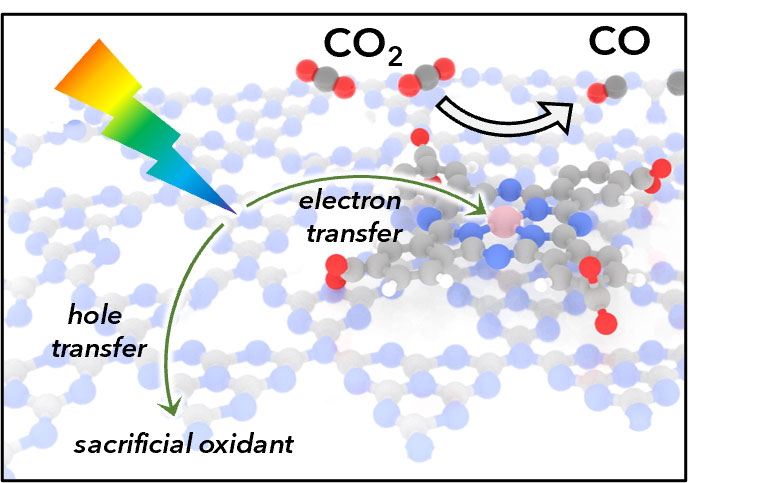In an Advance for Solar Fuels, Hybrid Materials Improve Photocatalytic Carbon Dioxide Reduction
A molecular catalyst integrated with a carbon nitride semiconductor harvests sunlight to rapidly and selectively convert carbon dioxide into carbon monoxide.

The Science
Carbon dioxide (CO2) is a greenhouse gas that forms when producing energy using fossil fuels. Scientists are working to transform CO2 into valuable chemicals or fuels using sunlight. To convert carbon dioxide into more useful carbon monoxide (CO), researchers have identified a new hybrid material that consists of a light-absorbing semiconductor and a cobalt catalyst. To synthesize this hybrid system, researchers had to develop a better way to attach the catalyst to the surface of the material. They also studied how the hybrid material performs light-driven chemistry. This will help scientists develop more efficient and durable systems to convert carbon dioxide into useful products.
The Impact
This study contributes to ongoing scientific efforts to find new ways to store energy. Converting CO2 into CO using sunlight could be a step toward storing solar energy in the form of a chemical fuel. This process could complement batteries and other energy storage technologies. To make these solar chemical fuels practical and viable, scientists must develop fast and efficient catalytic systems. This study advances the fundamental understanding of how light-absorbing hybrid systems can drive the catalytic production of chemical fuels using solar energy.
Summary
Hybrid materials for photocatalysis could leverage the high selectivity and efficiency imparted by a molecular catalyst synergistically with the durability of a solid material support. This research, carried out at the Center for Hybrid Approaches in Solar Energy to Liquid Fuels (CHASE) headquartered at the University of North Carolina at Chapel Hill, integrates a known cobalt catalyst onto the surface of a light-absorbing carbon nitride material. The research team included researchers from Yale University, Emory University, and North Carolina State University. The attachment strategy results in a high surface coverage of catalyst, and it arranges the molecules uniformly on the surface of the hybrid material. These two properties are key to high catalytic performance of this hybrid material, which very rapidly produces nearly exclusively CO from CO2.
Development of a high-performing photocatalytic system is a significant advance. To improve upon this discovery, scientists need to understand the material’s shortcomings and the way it promotes reactivity. These new investigations both identify the active state of the molecular catalyst and study the process that forms this active catalyst, revealing that it takes some time to generate the active and highly reduced form of the catalyst. Additionally, this research correlates a decrease in catalyst efficiency with decomposition of the catalyst itself, not the integrity of the entire hybrid system.
Contact
Daniel Kurtz
Technical Communications Manager, Center for Hybrid Approaches in Solar Energy to Liquid Fuels, UNC Chapel Hill
dakurtz@live.unc.edu
Hailiang Wang
Associate Professor of Chemistry, Yale University
hailiang.wang@yale.edu
Funding
This work was solely supported as part of CHASE, an Energy Innovation Hub funded by the Department of Energy, Office of Science, Office of Basic Energy Sciences. The Xe lamp used in this work was purchased with internal funding from the Center for Research on Interface Structures and Phenomena at Yale University.
Publications
Shang, B., et al., Monolayer Molecular Functionalization Enabled by Acid–Base Interaction for High-Performance Photochemical CO2 Reduction. ACS Energy Letters 7, 7, 2265-2272 (2022). [DOI: 10.1021/acsenergylett.2c01147]
Highlight Categories
Performer: University



